Shuai Tan
FixTalk: Taming Identity Leakage for High-Quality Talking Head Generation in Extreme Cases
Jul 02, 2025Abstract:Talking head generation is gaining significant importance across various domains, with a growing demand for high-quality rendering. However, existing methods often suffer from identity leakage (IL) and rendering artifacts (RA), particularly in extreme cases. Through an in-depth analysis of previous approaches, we identify two key insights: (1) IL arises from identity information embedded within motion features, and (2) this identity information can be leveraged to address RA. Building on these findings, this paper introduces FixTalk, a novel framework designed to simultaneously resolve both issues for high-quality talking head generation. Firstly, we propose an Enhanced Motion Indicator (EMI) to effectively decouple identity information from motion features, mitigating the impact of IL on generated talking heads. To address RA, we introduce an Enhanced Detail Indicator (EDI), which utilizes the leaked identity information to supplement missing details, thus fixing the artifacts. Extensive experiments demonstrate that FixTalk effectively mitigates IL and RA, achieving superior performance compared to state-of-the-art methods.
MambaControl: Anatomy Graph-Enhanced Mamba ControlNet with Fourier Refinement for Diffusion-Based Disease Trajectory Prediction
May 15, 2025Abstract:Modelling disease progression in precision medicine requires capturing complex spatio-temporal dynamics while preserving anatomical integrity. Existing methods often struggle with longitudinal dependencies and structural consistency in progressive disorders. To address these limitations, we introduce MambaControl, a novel framework that integrates selective state-space modelling with diffusion processes for high-fidelity prediction of medical image trajectories. To better capture subtle structural changes over time while maintaining anatomical consistency, MambaControl combines Mamba-based long-range modelling with graph-guided anatomical control to more effectively represent anatomical correlations. Furthermore, we introduce Fourier-enhanced spectral graph representations to capture spatial coherence and multiscale detail, enabling MambaControl to achieve state-of-the-art performance in Alzheimer's disease prediction. Quantitative and regional evaluations demonstrate improved progression prediction quality and anatomical fidelity, highlighting its potential for personalised prognosis and clinical decision support.
DreamRelation: Relation-Centric Video Customization
Mar 10, 2025Abstract:Relational video customization refers to the creation of personalized videos that depict user-specified relations between two subjects, a crucial task for comprehending real-world visual content. While existing methods can personalize subject appearances and motions, they still struggle with complex relational video customization, where precise relational modeling and high generalization across subject categories are essential. The primary challenge arises from the intricate spatial arrangements, layout variations, and nuanced temporal dynamics inherent in relations; consequently, current models tend to overemphasize irrelevant visual details rather than capturing meaningful interactions. To address these challenges, we propose DreamRelation, a novel approach that personalizes relations through a small set of exemplar videos, leveraging two key components: Relational Decoupling Learning and Relational Dynamics Enhancement. First, in Relational Decoupling Learning, we disentangle relations from subject appearances using relation LoRA triplet and hybrid mask training strategy, ensuring better generalization across diverse relationships. Furthermore, we determine the optimal design of relation LoRA triplet by analyzing the distinct roles of the query, key, and value features within MM-DiT's attention mechanism, making DreamRelation the first relational video generation framework with explainable components. Second, in Relational Dynamics Enhancement, we introduce space-time relational contrastive loss, which prioritizes relational dynamics while minimizing the reliance on detailed subject appearances. Extensive experiments demonstrate that DreamRelation outperforms state-of-the-art methods in relational video customization. Code and models will be made publicly available.
MotionStone: Decoupled Motion Intensity Modulation with Diffusion Transformer for Image-to-Video Generation
Dec 08, 2024



Abstract:The image-to-video (I2V) generation is conditioned on the static image, which has been enhanced recently by the motion intensity as an additional control signal. These motion-aware models are appealing to generate diverse motion patterns, yet there lacks a reliable motion estimator for training such models on large-scale video set in the wild. Traditional metrics, e.g., SSIM or optical flow, are hard to generalize to arbitrary videos, while, it is very tough for human annotators to label the abstract motion intensity neither. Furthermore, the motion intensity shall reveal both local object motion and global camera movement, which has not been studied before. This paper addresses the challenge with a new motion estimator, capable of measuring the decoupled motion intensities of objects and cameras in video. We leverage the contrastive learning on randomly paired videos and distinguish the video with greater motion intensity. Such a paradigm is friendly for annotation and easy to scale up to achieve stable performance on motion estimation. We then present a new I2V model, named MotionStone, developed with the decoupled motion estimator. Experimental results demonstrate the stability of the proposed motion estimator and the state-of-the-art performance of MotionStone on I2V generation. These advantages warrant the decoupled motion estimator to serve as a general plug-in enhancer for both data processing and video generation training.
Mimir: Improving Video Diffusion Models for Precise Text Understanding
Dec 04, 2024



Abstract:Text serves as the key control signal in video generation due to its narrative nature. To render text descriptions into video clips, current video diffusion models borrow features from text encoders yet struggle with limited text comprehension. The recent success of large language models (LLMs) showcases the power of decoder-only transformers, which offers three clear benefits for text-to-video (T2V) generation, namely, precise text understanding resulting from the superior scalability, imagination beyond the input text enabled by next token prediction, and flexibility to prioritize user interests through instruction tuning. Nevertheless, the feature distribution gap emerging from the two different text modeling paradigms hinders the direct use of LLMs in established T2V models. This work addresses this challenge with Mimir, an end-to-end training framework featuring a carefully tailored token fuser to harmonize the outputs from text encoders and LLMs. Such a design allows the T2V model to fully leverage learned video priors while capitalizing on the text-related capability of LLMs. Extensive quantitative and qualitative results demonstrate the effectiveness of Mimir in generating high-quality videos with excellent text comprehension, especially when processing short captions and managing shifting motions. Project page: https://lucaria-academy.github.io/Mimir/
Animate-X: Universal Character Image Animation with Enhanced Motion Representation
Oct 14, 2024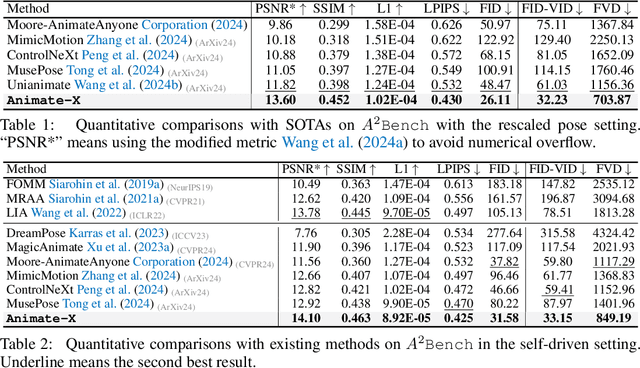
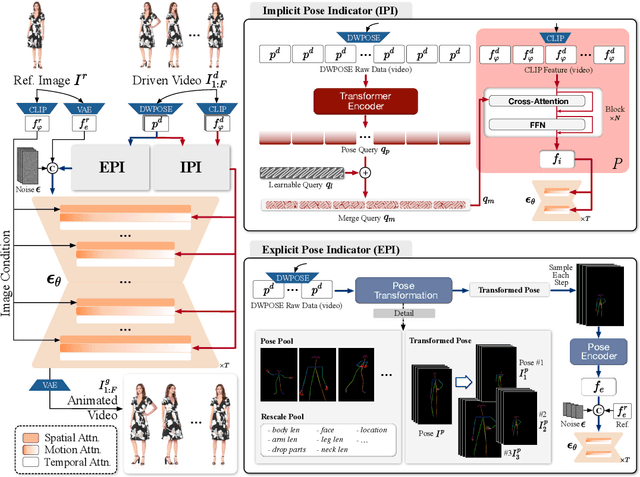
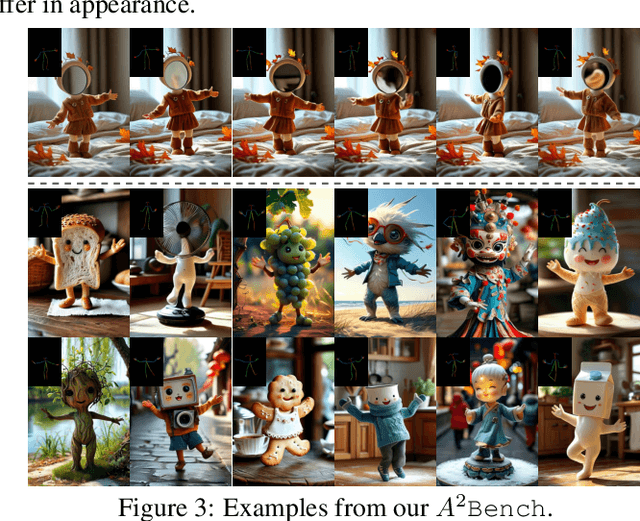
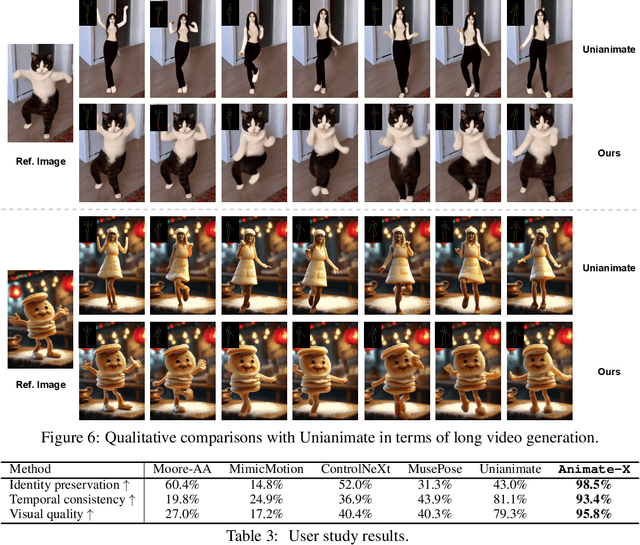
Abstract:Character image animation, which generates high-quality videos from a reference image and target pose sequence, has seen significant progress in recent years. However, most existing methods only apply to human figures, which usually do not generalize well on anthropomorphic characters commonly used in industries like gaming and entertainment. Our in-depth analysis suggests to attribute this limitation to their insufficient modeling of motion, which is unable to comprehend the movement pattern of the driving video, thus imposing a pose sequence rigidly onto the target character. To this end, this paper proposes Animate-X, a universal animation framework based on LDM for various character types (collectively named X), including anthropomorphic characters. To enhance motion representation, we introduce the Pose Indicator, which captures comprehensive motion pattern from the driving video through both implicit and explicit manner. The former leverages CLIP visual features of a driving video to extract its gist of motion, like the overall movement pattern and temporal relations among motions, while the latter strengthens the generalization of LDM by simulating possible inputs in advance that may arise during inference. Moreover, we introduce a new Animated Anthropomorphic Benchmark (A^2Bench) to evaluate the performance of Animate-X on universal and widely applicable animation images. Extensive experiments demonstrate the superiority and effectiveness of Animate-X compared to state-of-the-art methods.
EDTalk: Efficient Disentanglement for Emotional Talking Head Synthesis
Apr 02, 2024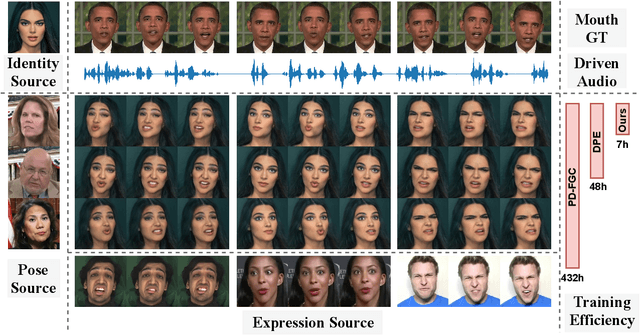
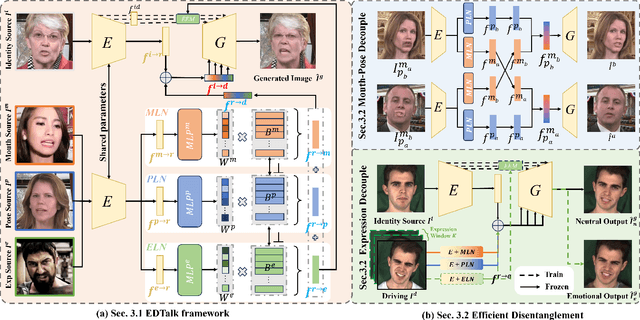
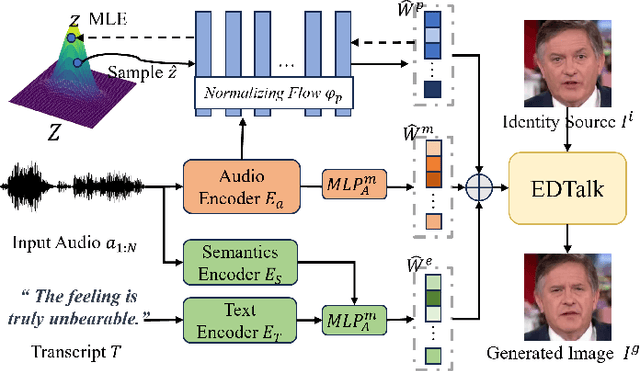
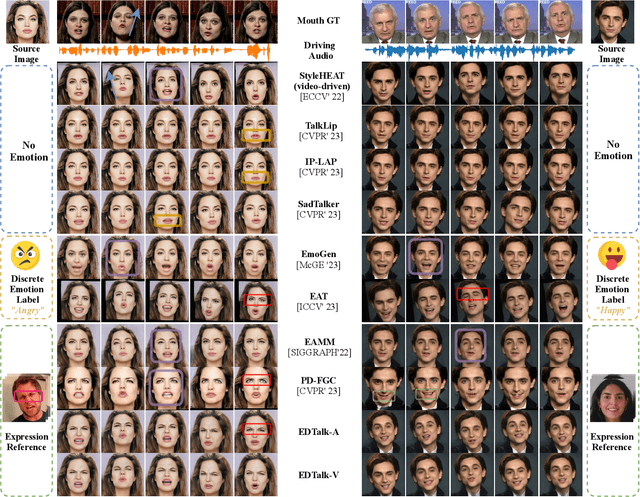
Abstract:Achieving disentangled control over multiple facial motions and accommodating diverse input modalities greatly enhances the application and entertainment of the talking head generation. This necessitates a deep exploration of the decoupling space for facial features, ensuring that they a) operate independently without mutual interference and b) can be preserved to share with different modal input, both aspects often neglected in existing methods. To address this gap, this paper proposes a novel Efficient Disentanglement framework for Talking head generation (EDTalk). Our framework enables individual manipulation of mouth shape, head pose, and emotional expression, conditioned on video or audio inputs. Specifically, we employ three lightweight modules to decompose the facial dynamics into three distinct latent spaces representing mouth, pose, and expression, respectively. Each space is characterized by a set of learnable bases whose linear combinations define specific motions. To ensure independence and accelerate training, we enforce orthogonality among bases and devise an efficient training strategy to allocate motion responsibilities to each space without relying on external knowledge. The learned bases are then stored in corresponding banks, enabling shared visual priors with audio input. Furthermore, considering the properties of each space, we propose an Audio-to-Motion module for audio-driven talking head synthesis. Experiments are conducted to demonstrate the effectiveness of EDTalk. We recommend watching the project website: https://tanshuai0219.github.io/EDTalk/
Say Anything with Any Style
Mar 13, 2024



Abstract:Generating stylized talking head with diverse head motions is crucial for achieving natural-looking videos but still remains challenging. Previous works either adopt a regressive method to capture the speaking style, resulting in a coarse style that is averaged across all training data, or employ a universal network to synthesize videos with different styles which causes suboptimal performance. To address these, we propose a novel dynamic-weight method, namely Say Anything withAny Style (SAAS), which queries the discrete style representation via a generative model with a learned style codebook. Specifically, we develop a multi-task VQ-VAE that incorporates three closely related tasks to learn a style codebook as a prior for style extraction. This discrete prior, along with the generative model, enhances the precision and robustness when extracting the speaking styles of the given style clips. By utilizing the extracted style, a residual architecture comprising a canonical branch and style-specific branch is employed to predict the mouth shapes conditioned on any driving audio while transferring the speaking style from the source to any desired one. To adapt to different speaking styles, we steer clear of employing a universal network by exploring an elaborate HyperStyle to produce the style-specific weights offset for the style branch. Furthermore, we construct a pose generator and a pose codebook to store the quantized pose representation, allowing us to sample diverse head motions aligned with the audio and the extracted style. Experiments demonstrate that our approach surpasses state-of-theart methods in terms of both lip-synchronization and stylized expression. Besides, we extend our SAAS to video-driven style editing field and achieve satisfactory performance.
FlowVQTalker: High-Quality Emotional Talking Face Generation through Normalizing Flow and Quantization
Mar 12, 2024Abstract:Generating emotional talking faces is a practical yet challenging endeavor. To create a lifelike avatar, we draw upon two critical insights from a human perspective: 1) The connection between audio and the non-deterministic facial dynamics, encompassing expressions, blinks, poses, should exhibit synchronous and one-to-many mapping. 2) Vibrant expressions are often accompanied by emotion-aware high-definition (HD) textures and finely detailed teeth. However, both aspects are frequently overlooked by existing methods. To this end, this paper proposes using normalizing Flow and Vector-Quantization modeling to produce emotional talking faces that satisfy both insights concurrently (FlowVQTalker). Specifically, we develop a flow-based coefficient generator that encodes the dynamics of facial emotion into a multi-emotion-class latent space represented as a mixture distribution. The generation process commences with random sampling from the modeled distribution, guided by the accompanying audio, enabling both lip-synchronization and the uncertain nonverbal facial cues generation. Furthermore, our designed vector-quantization image generator treats the creation of expressive facial images as a code query task, utilizing a learned codebook to provide rich, high-quality textures that enhance the emotional perception of the results. Extensive experiments are conducted to showcase the effectiveness of our approach.
Style2Talker: High-Resolution Talking Head Generation with Emotion Style and Art Style
Mar 12, 2024



Abstract:Although automatically animating audio-driven talking heads has recently received growing interest, previous efforts have mainly concentrated on achieving lip synchronization with the audio, neglecting two crucial elements for generating expressive videos: emotion style and art style. In this paper, we present an innovative audio-driven talking face generation method called Style2Talker. It involves two stylized stages, namely Style-E and Style-A, which integrate text-controlled emotion style and picture-controlled art style into the final output. In order to prepare the scarce emotional text descriptions corresponding to the videos, we propose a labor-free paradigm that employs large-scale pretrained models to automatically annotate emotional text labels for existing audiovisual datasets. Incorporating the synthetic emotion texts, the Style-E stage utilizes a large-scale CLIP model to extract emotion representations, which are combined with the audio, serving as the condition for an efficient latent diffusion model designed to produce emotional motion coefficients of a 3DMM model. Moving on to the Style-A stage, we develop a coefficient-driven motion generator and an art-specific style path embedded in the well-known StyleGAN. This allows us to synthesize high-resolution artistically stylized talking head videos using the generated emotional motion coefficients and an art style source picture. Moreover, to better preserve image details and avoid artifacts, we provide StyleGAN with the multi-scale content features extracted from the identity image and refine its intermediate feature maps by the designed content encoder and refinement network, respectively. Extensive experimental results demonstrate our method outperforms existing state-of-the-art methods in terms of audio-lip synchronization and performance of both emotion style and art style.
 Add to Chrome
Add to Chrome Add to Firefox
Add to Firefox Add to Edge
Add to Edge